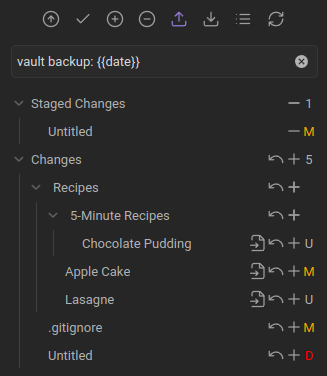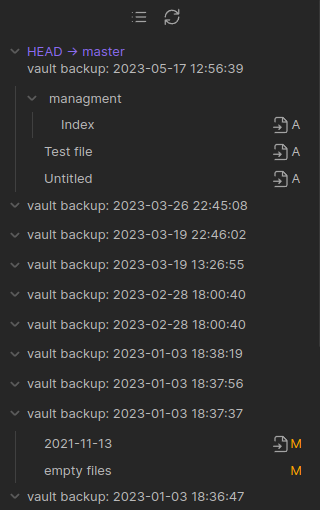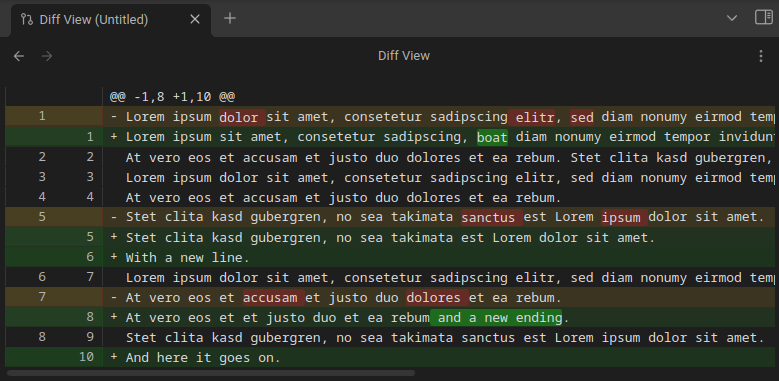 obsidian-git
obsidian-git
Integrate Git version control with automatic commit-and-sync and other advanced features in Obsidian.md
Top Related Projects
Integrate Git version control with automatic commit-and-sync and other advanced features in Obsidian.md
Community plugins list, theme list, and releases of Obsidian.
Task management for the Obsidian knowledge base.
Simple calendar widget for Obsidian.
Quick Overview
Obsidian Git is a plugin for the Obsidian note-taking application that integrates Git version control functionality directly into the Obsidian interface. It allows users to manage their Obsidian vault as a Git repository, enabling version control, backup, and synchronization features without leaving the Obsidian environment.
Pros
- Seamless integration with Obsidian, providing Git functionality within the familiar interface
- Automated backup and synchronization of notes across multiple devices
- Customizable commit messages and scheduling options for automatic commits
- Support for both local and remote Git repositories
Cons
- Requires basic knowledge of Git concepts for effective use
- May introduce complexity for users who are not familiar with version control systems
- Limited to Git functionality; does not support other version control systems
- Potential for conflicts if manual Git operations are performed outside of Obsidian
Getting Started
- Install the Obsidian Git plugin from the Obsidian Community Plugins section.
- Enable the plugin in Obsidian settings.
- Configure the plugin settings:
- Set up your Git username and email
- Choose your preferred backup interval
- Customize commit message templates
- Initialize your Obsidian vault as a Git repository or clone an existing repository.
- Use the command palette (Ctrl/Cmd + P) to access Git commands like "Commit all changes" or "Push".
Note: Ensure you have Git installed on your system before using this plugin.
Competitor Comparisons
Integrate Git version control with automatic commit-and-sync and other advanced features in Obsidian.md
Pros of obsidian-git
- Seamless integration with Obsidian for Git version control
- Automatic backup and synchronization of Obsidian vaults
- Customizable commit messages and backup intervals
Cons of obsidian-git
- Limited to Git-based version control
- Requires some Git knowledge for advanced usage
- May have performance impact on larger vaults
Code Comparison
Both repositories contain the same codebase, as they are the same project. Here's a sample from the main plugin file:
export default class ObsidianGit extends Plugin {
settings: ObsidianGitSettings;
gitManager: GitManager;
statusBar: StatusBar;
private readonly commands: Command[];
async onload() {
await this.loadSettings();
this.addSettingTab(new ObsidianGitSettingsTab(this.app, this));
// ... (additional code)
}
}
This code snippet shows the main plugin class structure, including settings management and initialization of Git-related functionality.
Community plugins list, theme list, and releases of Obsidian.
Pros of obsidian-releases
- Official repository for Obsidian releases, ensuring authenticity and reliability
- Provides comprehensive release notes and changelogs for each version
- Serves as a central hub for Obsidian's development progress and feature updates
Cons of obsidian-releases
- Focused solely on releases, lacking direct integration with Git for version control
- Does not offer customizable backup and sync options for Obsidian vaults
- Limited to official Obsidian updates, without community-driven enhancements
Code Comparison
obsidian-releases (release notes example):
## 1.1.16
- Improved PDF export
- Fixed various bugs related to editor and search
obsidian-git (configuration example):
{
"commitMessage": "vault backup: {{date}}",
"autoSaveInterval": 0,
"autoPullInterval": 0,
"autoPushInterval": 0,
"pullBeforePush": true
}
The obsidian-releases repository focuses on documenting official releases, while obsidian-git provides active Git integration for Obsidian vaults, allowing users to customize their backup and sync processes. obsidian-releases is essential for staying updated with official Obsidian developments, whereas obsidian-git offers more granular control over version management for individual users.
Task management for the Obsidian knowledge base.
Pros of obsidian-tasks
- Specialized task management functionality within Obsidian
- Advanced filtering and sorting options for tasks
- Supports recurring tasks and due dates
Cons of obsidian-tasks
- Limited to task management, doesn't offer version control
- May require more manual input for task creation and management
- Steeper learning curve for advanced features
Code comparison
obsidian-tasks:
const task = new Task({
description: "Example task",
status: Status.TODO,
dueDate: "2023-05-01"
});
obsidian-git:
const gitManager = new GitManager(vault);
await gitManager.pull();
await gitManager.stage();
await gitManager.commit("Commit message");
await gitManager.push();
The code snippets demonstrate the different focus areas of each plugin. obsidian-tasks is centered around task creation and management, while obsidian-git handles version control operations.
Simple calendar widget for Obsidian.
Pros of obsidian-calendar-plugin
- Provides a visual calendar interface for managing daily notes and events
- Offers customizable views (month, week, day) for better organization
- Integrates seamlessly with Obsidian's daily notes feature
Cons of obsidian-calendar-plugin
- Limited to calendar-specific functionality, not offering version control
- May require additional plugins for advanced note management
- Less suitable for collaborative work or syncing across devices
Code Comparison
obsidian-calendar-plugin:
export default class CalendarPlugin extends Plugin {
async onload() {
this.registerView(VIEW_TYPE_CALENDAR, (leaf) => new CalendarView(leaf));
this.addRibbonIcon("calendar", "Open Calendar", () => {
this.activateView();
});
}
}
obsidian-git:
export default class ObsidianGit extends Plugin {
async onload() {
this.addSettingTab(new ObsidianGitSettingsTab(this.app, this));
this.addCommand({
id: "pull",
name: "Pull from remote repository",
callback: async () => await this.pullChangesFromRemote(),
});
}
}
The code snippets show that obsidian-calendar-plugin focuses on creating a calendar view, while obsidian-git implements Git-related functionality like pulling changes from a remote repository.
Convert  designs to code with AI
designs to code with AI

Introducing Visual Copilot: A new AI model to turn Figma designs to high quality code using your components.
Try Visual CopilotREADME
Obsidian Git Plugin
A powerful community plugin for Obsidian.md that brings Git integration right into your vault. Automatically commit, pull, push, and see your changes â all within Obsidian.
ð Documentation
All setup instructions (including mobile), common issues, tips, and advanced configuration can be found in the ð full documentation.
ð Mobile users: Please check the dedicated Mobile section below.
⨠Key Features
- ð Automatic commit-and-sync (commit, pull, and push) on a schedule.
- ð¥ Auto-pull on Obsidian startup
- ð Submodule support for managing multiple repositories (desktop only and opt-in)
- ð§ Source Control View to stage/unstage, commit and diff files - Open it with the
Open source control viewcommand. - ð History View for browsing commit logs and changed files - Open it with the
Open history viewcommand. - ð Diff View for viewing changes in a file - Open it with the
Open diff viewcommand. - ð GitHub integration to open files and history in your browser
𧩠For detailed file history, consider pairing this plugin with the Version History Diff plugin.
ð¥ï¸ UI Previews
ð§ Source Control View
Manage your file changes directly inside Obsidian like stage/unstage individual files and commit them.

ð History View
Show the commit history of your repository. The commit message, author, date, and changed files can be shown. Author and date are disabled by default as shown in the screenshot, but can be enabled in the settings.

ð Diff View
Compare versions with a clear and concise diff viewer.
Open it from the source control view or via the Open diff view command.

âï¸ Available Commands
Not exhaustive - these are just some of the most common commands. For a full list, see the Command Palette in Obsidian.
- ð Changes
List changed files: Lists all changes in a modalOpen diff view: Open diff view for the current fileStage current fileUnstage current file
- â
Commit
Commit: If files are staged only commits those, otherwise commits only files that have been stagedCommit all changes: Commits all changes without pushingCommit all changes with specific message: Same as above, but with a custom messageCommit staged with specific message: Same as above, but with a custom message
- ð Commit-and-sync
Commit-and-sync: With default settings, this will commit all changes, pull, and pushCommit-and-sync with specific message: Same as above, but with a custom messageCommit-and-sync and close: Same asCommit-and-sync, but if running on desktop, will close the Obsidian window. Will not exit Obsidian app on mobile.
- ð Remote
Push,PullEdit remotesRemove remoteClone an existing remote repo: Opens dialog that will prompt for URL and authentication to clone a remote repoOpen file on GitHub: Open the file view of the current file on GitHub in a browser window. Note: only works on desktopOpen file history on GitHub: Open the file history of the current file on GitHub in a browser window. Note: only works on desktop
- ð Manage local repository
Initialize a new repoCreate new branchDelete branchCAUTION: Delete repository
- 𧪠Miscellaneous
Open source control view: Opens side pane displaying Source control viewEdit .gitignoreAdd file to .gitignore: Add current file to.gitignore
ð» Desktop Notes
ð Authentication
Some Git services may require further setup for HTTPS/SSH authentication. Refer to the Authentication Guide
Obsidian on Linux
- â ï¸ Snap is not supported.
- â ï¸ Flatpak is not recommended, because it doesn't have access to all system files.
- â Please use AppImage or a full access installation of your system's package manager instead (Linux installation guide)
ð± Mobile Support (â ï¸ Experimental)
The Git implementation on mobile is very unstable! I would not recommend using this plugin on mobile, but try other syncing services.
𧪠The Git plugin works on mobile thanks to isomorphic-git, a JavaScript-based re-implementation of Git - but it comes with serious limitations and issues. It is not possible for an Obsidian plugin to use a native Git installation on Android or iOS.
â Mobile Limitations
- No SSH authentication (isomorphic-git issue)
- Limited repo size, because of memory restrictions
- No rebase merge strategy
- No submodules support
â ï¸ Performance Caveats
[!caution] Depending on your device and available free RAM, Obsidian may
- crash on clone/pull
- create buffer overflow errors
- run indefinitely.
It's caused by the underlying git implementation on mobile, which is not efficient. I don't know how to fix this. If that's the case for you, I have to admit this plugin won't work for you. So commenting on any issue or creating a new one won't help. I am sorry.
Setup: iPad Pro M1 with a repo of 3000 files reduced from 10000 markdown files
The initial clone took 0m25s. After that, the most time consuming part is to check the whole working directory for file changes. On this setup, checking all files for changes to stage takes 03m40s. Other commands like pull, push and commit are very fast (1-5 seconds).
Tips for Mobile Use:
The fastest way to work on mobile if you have a large repo/vault is to stage individual files and only commit staged files.
ð Contact & Credits
- The Line Authoring feature was developed by GollyTicker, so any questions may be best answered by him.
- This plugin was initial developed by denolehov. Since March 2021, it's me Vinzent03 who is developing this plugin. That's why the GitHub repository got moved to my account in July 2024.
- If you have any kind of feedback or questions, feel free to reach out via GitHub issues or
vinzent3on Obsidian Discord server.
â Support
If you find this plugin useful and would like to support its development, you can support me on Ko-fi.
Top Related Projects
Integrate Git version control with automatic commit-and-sync and other advanced features in Obsidian.md
Community plugins list, theme list, and releases of Obsidian.
Task management for the Obsidian knowledge base.
Simple calendar widget for Obsidian.
Convert  designs to code with AI
designs to code with AI

Introducing Visual Copilot: A new AI model to turn Figma designs to high quality code using your components.
Try Visual Copilot